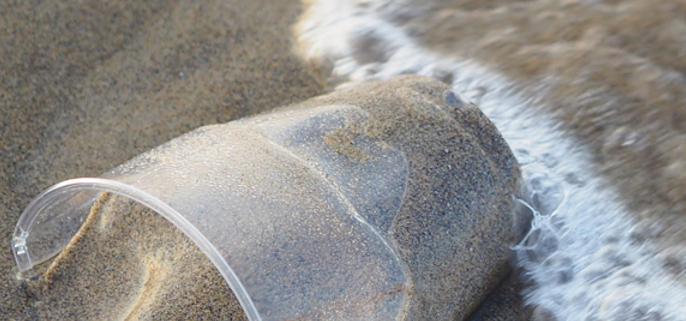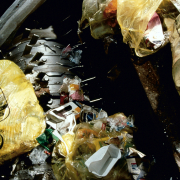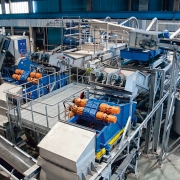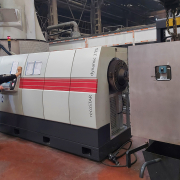Cleaning Oceans from Plastic
There are many groups and projects to fight the surface plastic or collect material at the beach. But what is ocean cleaning really standing for?
Without urgent action, the estimated 11 million metric tons of plastic currently entering the ocean annually will triple in the next twenty years. This would mean between 23 and 37 million metric tons of plastic flowing into the ocean every year by 2040. That is equivalent to 50 kilograms of plastics per meter of coastline worldwide, the UNEP report “From Pollution to Solution” indicates. But where does the waste come from and where does it end?
The provenance is obvious: Of 275 million tons of plastic waste annually, 99,5 million tons are generated by people living within 50 kilometers of a coastline, of which 31,9 million tons are discarded or mismanaged coastal plastic waste, littered or stored in landfills prone to leakage or loss. In the end, eight million tons of plastic enter the oceans annually, Jenna R. Jambeck, researcher at the University of Georgia, found out in 2015. Recent research speaks of nine million tons. In other words, a garbage truckload of plastic enters the ocean every minute, the Ocean Conservancy rated. According to UNEP, it can only be estimated that 75 to 199 million tons of plastic are currently found in the oceans.
Resulting from poor waste management practices
The pathway of the material starts with mismanaged plastic waste, including residues littered and abandoned or inadequately disposed of in dumps or uncontrolled landfills. Most of this material results from poor waste management practices – particularly in low-to-middle income countries. According to an article on “Plastic Pollution” by Hannah Ritchie and Max Roser, between 80 and 90 percent of the inadequate disposal of plastic waste is practiced across countries in South Asia and Sub-Saharan Africa. Nevertheless, even high-income regions like Europe, North America, Australia, New Zealand, Japan and South Korea contribute to a littering rate of two percent. In “Marine Plastic Debris & Microplastics” in 2016, the UNEP cited that around 16 of the top 20 contributors to plastic marine litter were from middle-income countries with economic growth rapidly occurring. The top five countries – such as China, Indonesia, Philippines, Sri Lanka and Vietnam – were said to account for more than 50 percent of mismanaged plastics.
From textiles, tires and city dust
Plastic wastes include all size residues, from large visible and easily removable items to small invisible particles. The “visible” waste includes construction, household goods, packaging, coastal tourism, as well as food and drink packaging, while the „invisible“ stems from even more sources. But the actual quantities remain largely unknown. “Reliable quantitative comparisons between the input loads of macro- and microplastics, their sources, originating sectors and users are not possible at present, and this represents a significant knowledge gap,” the UNEP must confess. A paper on “Primary Microplastics in the Oceans”, edited by the International Union for Conservation of Nature and Natural Resources, at least separates different sources of microplastics: 77 percent by private passenger transport and household activities and 23 percent by industries through freight transports and economic activities. Their releases to sea consist of 34.8 percent of synthetic textiles, 28.3 percent of the abrasion of automotive tires and 24.2 percent of city dust. The rest consists of road markings, marine coatings, personal care products and plastic pellets. The global release of primary microplastics to the world’s oceans totals up to 1.5 million tons per year. (Secondary microplastics are degraded larger plastic items and even less quantifiable ones.)
Seven percent from atmospheric fallout
There are many possibilities for land-based plastics and especially microplastics to enter the oceans. The smaller the particles, the greater the chance to reach waterways via leachates from landfill sites, sludge from wastewater, run-off from agriculture or leftover from shipbreaking or harbor activities. Most astonishing is the fact, that microplastic fibers and airborne particles – especially from wear and tear on tires – can travel long distances. The authors of the “Primary Microplastics”-Paper estimate that seven percent of land-based ocean plastic results from atmospheric fallout featuring 15 percent of the ocean release. But, of course, wind and storms can also transport other lightweight micro- and macroplastics to places, where the material may be stored temporarily or reaches rivers or the sea.
The river’s load
But whether the macroplastic waste derives from the private use of shopping bags, packaging or sanitary items or stems from commercial and industrial treatment, whether the microplastic comes from industrial abrasives, printing powders, vehicle tires, fabrics or clothing: “80 percent of the world’s ocean plastics enter the ocean via rivers and coastlines”, argued Hannah Ritchie in 2021 in an article on derivation of plastic in the oceans. She gets rid of a former belief, that 56 to 91 percent of the ocean plastics come via just ten rivers – other figures indicate 88 to 95 percent. The New Zealand oceanographer Laurent Lebreton published in the scientific journal Nature in 2017 and 2019 that especially the largest and most polluted rivers are mainly responsible for a load of between 1.1 and 2.4 million tons of plastic every year being carried to the seas. New research suggests that 1,600 rivers are responsible for 80 percent of the plastic inputs to the oceans – the Asian rivers with a share of 81 percent and the Philippine’s rivers even with one-third of the global total amount. “Plastic Pollution” puts the Indian Ganges (115,000 t/y) as well as the Chinese XI (73,900 t/y) and Huangpu (40,800 t/y) in China among the greatest transporters of plastic load to sea in 2015, but the Chinese Yangtze River is leading with 333,000 t/y. In April 2018, the British Verdict-network published that the Yangtze deposited 1.5 million of the total 2.75 million metric tons of plastic waste deposited into the ocean – 55 percent of all river marine plastic pollution worldwide. A German study on the export of plastic debris confirms the Yangtze has an annual microplastic load of 164,332 tons.
Annually 12.2 million tons enter the sea
The British independent consultancy Eunomia assumes that the load of land-based coastal waste – generated within 50 kilometers of a coastline – amounts to nine million tons per year, together with 0.5 million tons of inland-produced waste. The fishery stands for ALDFG – abandoned, lost and discarded fishing gear – and material from aquaculture caused by accidental loss or illegal disposal. This fishery litter accounts for 1.15 million tons. Shipping litter – a total of 0.6 million tons – results from illegal disposal at commercial shipping, cruise shipping and recreational activities in boats and at the beach. Together with 0.96 million tons of microplastics, especially from vehicle dust, pellet spills and textiles, 12.2 million tons enter the marine environment every year.
Fighting the surface plastic
According to Eunomia, the waste gets diverted into the ocean. One percent of total stays on the ocean surface, five percent are washed ashore, while 94 percent sink to the seafloor. There are many groups and projects to fight surface plastic. The lost fishing nets containing precious material are a central theme to, for example, the Global Ghost Gear Initiative, the Healthy Seas initiative, Net-Works and EUfir – the short form of “A European system for collecting and recycling discarded equipment from the fishing and fish farming industry”. Other organizations concentrate on cleaning the seawater from waste. The non-profit Ocean Cleanup, for instance, raised 31.5 million US-Dollar to halve plastic waste out of the “Great Pacific Garbage Patch” within five years. SeaCleaners tries to prohibit the entry of plastic waste into the ocean by professional collection at the outlet of big rivers like Jangtsekiang, Yellow River, Indus, Mekong and Nile. So does the start-up Everwave – former Pacific Garbage Screening – with its CollectiX, a flexible waste collection boat with a capacity of ten tons of garbage within three days and with a passive cleanup platform in development able to act in rivers and to anchor. German-based Plastic Fischer is convinced to run the best cleaning system compared to Ocean Cleanup Interceptor, Everwaver and the Great Bubble Barrier in the Netherlands: Like waste collection by fishermen, it produces locally, uses low tech and is able to work cost-efficient.
Beach cleanup – a tremendous task
Some companies engage in collecting material at the beach. Waste Free Ocean wants to mobilize fisheries, recyclers, manufacturers and policymakers to reduce, reuse and ultimately recycle marine litter. Their Mixed Plastic Waste Project, for example, is performing beach clean-ups on the North Adriatic coast and along the River Po in Italy; the beach plastic waste is sorted to be suitable for recycling. And Prevented Ocean Plastic wanted to enable people around the world to earn a living, clean their coastlines and prevent ocean plastic. Plastic Punch, a non-profit organization in Accra, Ghana, aims at protecting the coastal environment from plastic waste; on a beach cleanup in 2019, 200 volunteers collected four tons of waste including 210,600 plastic bottles that were turned into bricks for road construction or shredded to produce textiles. If not done by volunteers, clean-ups are expensive: An article in National Geographics cites a study estimating the costs for tidying beaches along 90 towns in Washington, Oregon, and California at more than 500 million US-Dollar. Otherwise, they offer the chance to make money. TerraCycle for example states the “collection” of over 150 tons of what they call „beach plastic“: nylon rope, fishing nets, and plastic bags are sent to the company. Anyway, the task is tremendous. At one of the biggest events – the International Coastal Clean-up in 2012 – the volunteers collected approximately 4,513 tons of beach litter from 26,700 km of coast, but it covered only 1.9 percent of the global coastlines of 1.4 million km and of estimated 236,331 tons.
At ground level
Little is known about the cleaning of the marine floor. Merely the SeaClear project has begun to fetch waste from the depth. The Horizon 2020 funded project relies on the help of robots and artificial intelligence. The five steps of a dive include: “A surface vessel scans the sea bottom, marking any large debris that it finds. In clear water, a drone searches for litter from the air. An observation robot searches underwater. A second underwater robot collects the litter. Litter is collected in a basket.” Although the costs are 70 percent lower compared to divers, the system is still in development, and the technique seems to be far too under-dimensioned for the target: If today‘s oceans contain 26 to 66 million tons of waste, the material located on the seafloor with approximately 94 percent adds up to 24 to 62 million tons.
Estimated 175 billion US-Dollar needed
Sustainable Development Goal Number 14 is targeting to “conserve and sustainably use the oceans, seas and marine resources for sustainable development.” In 2020, Despina F.Johansen and Rolf A.Vestvik tried to estimate the costs of saving the oceans in this effect. While currently only 25,5 billion US-Dollar are funded, around 174.52 billion US-Dollar per year are needed, according to the study. Half the money needed is scheduled for – first of all – limiting plastic and marine pollution. This includes cleaning up ocean trash, better managing waste, improving wastewater treatment plants as well as investing in research on biodegradable plastics. Some 30 billion US-Dollar could help to rehabilitate wetland ecosystems, coastal habitats and coral reefs. To remediate the seaside ecosystems would need further investment.
To “catalyze private sector investment”
There are lots of funds ready to be invested in ocean waste cleaning. In October 2018 for instance, the EIB (European Investment Bank), the KfW (Kreditanstalt Für Wiederaufbau) Group and the Agence Française de Développement (AFD) launched the Clean Oceans Initiative (COI) providing 1.6 billion Euro financing as of February 2022. In 2021, they – together with the ADB Oceans Financing Initiative – started cooperating under the Clean and Sustainable Ocean Partnership. The Blue Sustainable Ocean Strategy (“Blue SOS”) launched by the EIB aimed to improve the health of oceans, build stronger coastal environments and boost blue sustainable economic activity by committing to lend 2.5 billion Euro over the period 2019-2023 to sustainable ocean projects; the EIB expects to mobilize at least five billion Euro of investments. Already in May 2019, the Asian Development Bank (ADB) launched the Action Plan for Healthy Oceans and Sustainable Blue Economies for the Asia and Pacific region, financing and technical assistance for ocean health and marine economy projects to five billion US-Dollar from 2019 to 2024, including co-financing from partners. US-based DFC Ocean Plastics Initiative announced 2.5 billion US-Dollar in 2020 for its new Ocean Plastics Initiative seeking to “catalyze private sector investment” in developing efficient waste management, recycling, and other infrastructure projects in countries like Indonesia. Other sources of financing with partially other targets include the Africa Circular Economy Facility, the Africa Green Loop Fund, Africa50, the Althelia Sustainable Ocean Fund, CDP Matchmaker, the Fund for African Private Sector Assistance, the World Bank hosted PROBLUE and the Seed Capital Assistance Facility.
Prevention
A look at the funded measures shows that the programs are not intended to primarily clean the sea. The Clean Oceans Initiative for example supports the public and private sector in implementing sustainable projects that reduce or avoid plastics and other waste and clean up waste and wastewater before it reaches the ocean. The Action Plan for Healthy Oceans and Sustainable Blue Economies launched by ADB reduces land-based sources of marine pollution, including plastics, wastewater, and agricultural runoff. It is improving sustainability in port and coastal infrastructure development. It is creating inclusive livelihoods and business opportunities in sustainable tourism and fisheries. And – amongst others – it also wants to protect and restore coastal and marine ecosystems and key rivers.
It is characteristic, that an article on “Five European companies helping to clean up the oceans”, published by the online-magazine Aquatech, presents:
- Ocean Cleaning – a solution “to efficiently intercept plastic in rivers before it reaches the oceans”
- Great Bubble Barrier – “that catches waste in rivers and canals to prevent it from reaching the oceans”
- River Cleaning “with the mission to prevent plastic waste from reaching the seas/oceans”
- Serious Business helping “to create a circular use of plastic for major brands”
- and Ichthion’s three solutions: a “barrier designed to be deployed in rivers to prevent plastic waste from reaching marine environments”, a self-cleaning system „to extract plastic pollution from fluvial and marine environments“ and a system for large shipping vessels „to collect large volumes of plastic whilst preventing high marine collateral“.
In one word: These companies definitely “helping to clean up the oceans” are intended to stop plastic waste before it reaches the sea.
Mostly land-based strategies
In 2015, Ocean Conservancy and the McKinsey Center for Business and Environment published a study called “Stemming the tide”. Its subtitle running “Land-based strategies for a plastic-free ocean” brings the target to the market: It is not the plastic carpet in the ocean that needs to be cleaned up first of all – it is the daily ongoing new pollution by new materials brought to the sea by rivers. In this spirit, the hypothesis of the study suggests that interventions in China, Indonesia, the Philippines, Thailand, and Vietnam could already reduce global plastic-waste leakage by approximately 45 percent over the next ten years. This is exactly what for instance CounterMeasure, managed by the UN Environment Programme’s Regional Office for Asia and the Pacific, wants: to identify sources and pathways of plastic pollution in river systems in Asia, particularly the Mekong and the Ganges, to develop plastic leakage models for localities in six different countries and to deploy technologies to augment ground-level research.
Tolerant capital needed
As seen in the passages before, Ocean cleaning is not only an investment in the environment: It is an investment in the (circular at most) economy too. Investment management firm Circulate Capital for example will be financing companies that prevent the flow of ocean plastic waste to the world’s ocean „and advance the circular economy in South and Southeast Asia“. In late 2019 in Singapore, it announced its own Ocean Fund with the backing of PepsiCo, Procter & Gamble, Dow, Danone, Chanel, Unilever, The Coca-Cola Company, and Chevron Phillips Chemical, for scaling local innovative companies or projects “that divert waste from the environment and into the recycling value chain in South and Southeast Asian countries”. In 2020, the fund started by investing 40 million US-Dollar in seven companies in India and Indonesia. Already in 2019, Forbes magazine cited banking and insurance expert Rob Kaplan – obviously involved in this fund – pleading that “tolerant capital is needed to incubate and invest in the companies and infrastructure projects that will become the future of waste and recycling across the region”.
The purpose of the authors of “Stemming the tide” sounds much more ecological and social, but also more utopian: Ocean cleaning “is also a potential engine of job growth and could result in the creation of hundreds of thousands of jobs across our priority countries while creating secondary industries for waste treatment and playing a role in the development of a robust renewable energy sector.”
(Published in GLOBAL RECYCLING Magazine 1/2023, Page 13, Photo: flockine / pixabay.com)








